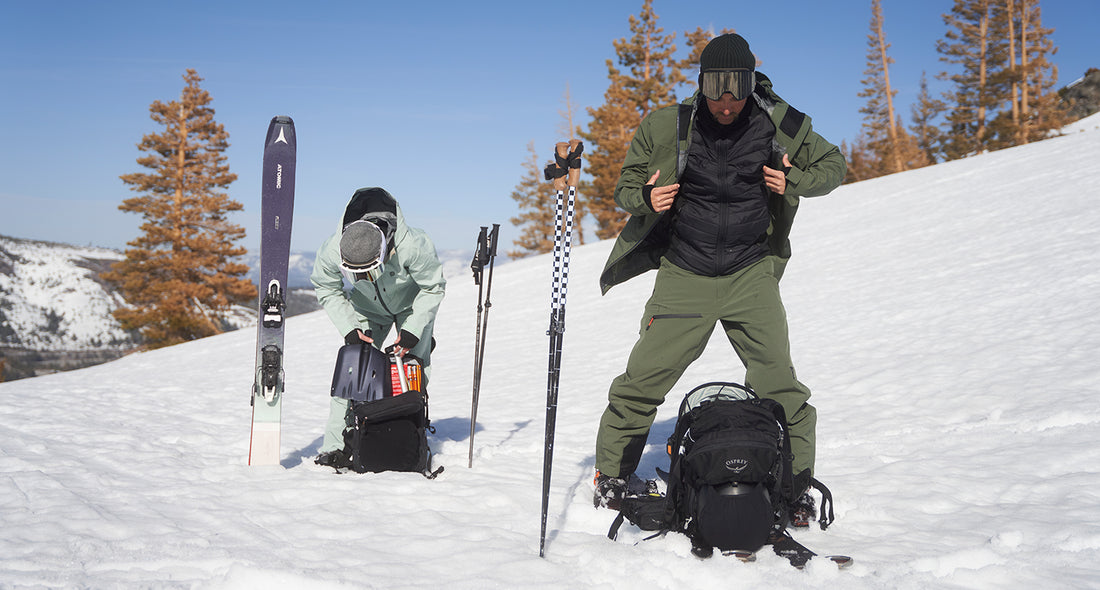If you’re planning on hitting the slopes for the first time, or making a comeback from a prolonged hiatus, you might be wondering what to wear for your upcoming ski or snowboard trip. In this guide, we’ll cover the layering basics that’ll keep you warm, dry and comfy from first to last chair.
Here our the layering basics you need for skiing and snowboarding at a quick glance:
- Thermals or baselayers
- Midlayer (puffer or fleece)
- Outer Layer (snow jacket and pants)
- Accessories (snow gloves, face-wear, beanie, socks)
How to layer for the snow
We’re going to break down each layer so you can choose the right snow gear for you. That means more time chasing pow lines and less time waiting in store lines.
Thermals and Baselayers
It all starts with your thermals and baselayers. These bad boys help keep your core temperature stable as your body heats up (e.g. skiing and snowboarding down a run or traversing a trail) and cools down (e.g. when you’re sitting still on a chair lift).
For us, Australian Merino wool thermals are a natural choice. Not only are they a sustainable option, 100% biodegradable, natural and renewable, but they also feature performance-enhancing benefits such as:
- Thermoregulating: Warm you up as you start to get cold and cool you down as your body temp heats up
- Moisture-wicking: Keeps you dry as you start to sweat by pulling moisture away from the skin
- Odour-resistant: Comes in handy during apres. Trust us
Not sure what size to get? Opt to wear your thermals slightly fitted but with room to move. This will help regulate your core temperature better than a looser fitting baselayer.
Midlayer
Next in your layering line-up is the trusty midlayer. The perfect choice for what to wear under your ski or snowboard jacket.
When it comes to midlayers, there a few options to pick from:
- Puffer Jacket: This is a great option if you’re heading to extra cold climates or your snow jacket has minimal insulation
- Fleece: A fleece will offer less warmth than a puffer but works well if your ski or snowboard jacket is highly insulated already
- Vest: Feel the heat? Opt for a vest so your core keeps warm but enjoy added coolness with your arms free
Outer Layer
Your waterproof jacket and pant outer layer is what’s going to protect you from wet, snowy conditions. It's the choice of either a ski jacket and pants or snowboard jacket and pants.
The difference? These days there’s not much of a difference between ski gear and snowboard clothes. Mostly, you’ll find skiwear is slightly more fitted and often touted as a classic cut. Whereas snowboarding jackets and pants will often fit looser and slightly taller.
Some key features you want to find in your ski or snowboard outerwear include:
- Waterproof rating: Best to opt for a minimum of 10K
- Specialised pockets: Ski pass pockets, goggle pockets, pockets to stash your mobile
- Vents: Riding mountains can be sweaty business so to help regulate your temperature snow jackets and pants can feature vents. Zip them open to let in a breeze and close them up as you start to cool down
- Adjustable features: Whether you wear snow bib pants with adjustable straps or ski pants with an adjustable waist, it’s always a good idea to look for little features that can adjust to your changing shape as a result of the layers you may or may not be wearing
Accessories
It’s the little things that count and when it comes to skiing or snowboarding, your accessories can make or break your day on the slopes.
Always remember to throw on:
- A beanie to keep your head warm. Quick tip - if you’re wearing a helmet it’s always best to take your beanie off so that your helmet fits correctly on your head. Throw it in a pocket so you’re ready when apres hit
- Waterproof snow gloves. We opt for leather gloves or mittens as they only soften with age to fit, well, like a glove. We also recommend going for a GORE-TEX glove to guarantee dry hands
- A facemask will help block the wind and protect your nose and lips from frosty conditions. Pull up as you speed down the mountain and pull down if you need a breath of fresh air
- Ski and snowboard socks. Just like thermals, we opt for Australian Merino wool snow socks because of all the added benefits. Look for socks that are thin and long and make sure they are fitted to avoid bunching under your ski or snowboard boots
Shop Ski and Snowboarding Gear
So, all that’s left to do is gear up and head to the mountains. Luckily, we have all your snow layering needs for skiing and snowboarding under one, website-happy roof. Convenient huh?
See you out there!

